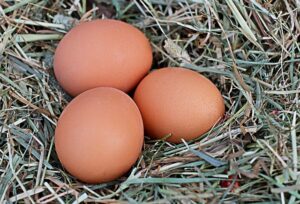Backyard poultry farming is more than just a trendy hobby; it’s a gateway to self-reliance and, for many, an important source of food. The crowning glory of this endeavor is the humble yet extraordinary egg. It’s a small, protein-packed wonder that takes a village of nutrients, health, and optimum conditions to lay. However, the egg-laying process is not always smooth. Just like any creature, chickens can encounter health or environmental issues that affect their reproductive systems. In this comprehensive guide, we’ll help you understand the intricacies of chicken egg laying problems and provide practical solutions to keep your flock clucking contently.
The Tell-Tale Signs of Egg-Laying Woes
Before we crack into the specifics of egg-laying issues, it’s essential to know the red flags. If you’ve noticed a decrease in egg production, irregular eggs, or signs of distress in your hens, you might have an egg-laying problem on your hands. These signals shouldn’t be taken lightly, as they can be indicative of issues that need immediate attention.
Common Indicators of Egg-Laying Problems Include:
- Soft, Misshapen, or No Shell Eggs: Sometimes, your hens might lay eggs without the protective hard shell. This can result from a variety of issues, from nutritional deficits to diseases.
- Lethargic or Distressed Behavior: A hen that is straining, unable to pass an egg, or generally not herself could be experiencing egg-related discomfort.
- Sudden Drops in Egg Production: If you’re seeing a significant decrease in the number of eggs your hens lay per week, it’s a sign that something might be amiss.
- Egg-Laying Outside the Nest Box: Normal hens will lay their eggs in designated areas, typically a nest box. If you see eggs laid elsewhere, this might indicate the bird is in distress or has an environmental concern.
Now that we can recognize the symptoms, it’s time to hatch a plan to address these challenges head-on.
Soft-Shelled Eggs: A Fragile Situation
Hens are nature’s efficient egg producers, with complex systems that work like clockwork under ideal circumstances. But when they start laying soft-shelled eggs, their mill is clearly malfunctioning. We’re going to diagnose the issue and, most importantly, offer treatment plans.
Unpacked: What Causes Soft-Shelled Eggs?
Soft-shelled eggs typically stem from one of three problems:
- Calcium Deficiency: The building blocks of a hard eggshell, calcium, and a lack thereof can cause shell malformations.
- Vitamin D3 Insufficiency: Vitamin D3 aids calcium absorption; without it, your hens won’t make the most of their calcium intake.
- Stress or Illness: This can redirect calcium from eggshell production to other vital functions, causing shell issues.
The Egg’s Too Soft! Now What?
- Supplementation: Provide your flock with a calcium boost through oyster shell supplements or incorporating crushed eggshells into their diet.
- Balanced Diet: Ensure your hens are getting a formulated diet rich in all needed nutrients, including calcium and D3.
- Stress Reduction: Limit your hens’ exposure to loud noises, overcrowding, or other stressors that could affect egg production.
Your hens will eventually shell out normal eggs once these adjustments are in place.
The Sticky Situation of Egg Binding
Imagine trying to pass an egg that’s too large or underdeveloped to leave your body. For a hen suffering from egg binding, it’s more than just a mental picture—it’s a real, life-threatening condition that calls for immediate intervention.
Identifying and Addressing Egg Binding
Egg binding, also known as “egg dystocia,” is when an egg is retained in the reproductive tract. Symptoms can include:
- Lethargy and Depression
- Abdominal Straining
- Sudden Decrease in Egg Production
In cases where the hen is unable to pass the egg on her own, it’s critical to provide assistance. This may involve carefully lubricating the vent and gently massaging the abdomen to guide the egg out. However, extreme care must be taken, as the egg can break and cause peritonitis, a life-threatening infection. Consult with a vet immediately if you’re not confident in your ability to assist the hen.
The Enigma of Egg Drop Syndrome (EDS)
EDS is a viral disease that impacts hens’ reproductive tracts, leading to a significant decrease in egg production. While less common than some other egg-laying issues, its consequences are severe for affected flocks. Prevention is better than cure when it comes to EDS, as there are no specific treatments.
Recognizing EDS in Your Flock
Expect the following signs if EDS has taken hold:
- Up to 50% Drop in Egg Production
- Irregular Shells and Composition
- Respiratory Distress in Some Cases
Protecting Your Flock from EDS
Preventative measures include:
- Vaccinations: A sound vaccination strategy can protect your flock from the worst outcomes of EDS. Vets recommend vaccination during the pullet stage.
- Cleaning and Disinfecting: EDS is highly contagious, so keeping your coop clean and disinfected can help prevent its spread. Be sure to thoroughly clean all equipment, including feeders and waterers.
- Biosecurity Measures: Limiting access to your flock and practicing strict biosecurity measures can also aid in preventing an EDS outbreak.
With EDS, as with other poultry diseases, vigilance and preventative care are key.
Nutritional Deficiencies: The Diet’s Role in Egg Production
A balanced diet is not just for humans; it’s the bedrock of every healthy egg-laying hen. If your flock is experiencing egg-related ailments, take a closer look at what’s on the menu.
The Essentials for Egg-Laying Diets
For robust egg production, hens need a diet rich in:
- Protein: Essential for ovulation and egg albumin production.
- Calcium: For forming that necessary shell structure.
- Vitamin D3: Regulates calcium levels, ensuring shells are properly formed.
- Omega-3 Fatty Acids: Enhances egg nutritional value.
Diagnosing and Addressing Deficiencies
Conduct a diet audit to ensure all necessary nutrients are present. If you find any shortfalls, make the following adjustments:
- Supplement Key Nutrients: Add to their feed or water to correct deficiencies.
- Vary Their Diet: Offer a diverse range of feeds, greens, and insects to cover all nutritional bases.
Remember, a healthy diet leads to healthy eggs.
It’s Not Just What They Eat, But Where They Sit: Environmental Factors
Creating an ideal environment is critical for maximizing egg production. Factors such as lighting, temperature, and stress levels can all influence the frequency and quality of egg-laying.
Lighting: The Sun’s (and Your) Ally
- Daylight Synthetics: Artificial lights can be used to extend daylight hours, encouraging hens to lay throughout the winter months.
- The Dimmer the Day: Ensure hens have enough designated “dark” hours for rest and recuperation, typically 6 to 8 hours per day.
Temperature and Humidity: Comfort Equals Productivity
- Not Too Hot, Not Too Cold: A comfortable temperature ranging from 55 to 75 degrees Fahrenheit promotes regular laying.
- Humidity Matters: Aim for a relative humidity level of around 40%–60% to prevent eggs from drying out or becoming too sticky.
A Stress-Free Zone
- Personal Space: Allow ample room for each bird to minimize social stress.
- Predator Protection: Keep your flock safe and secure to prevent stress reactions.
Remember, a happy hen is a better producer.
Health and Disease Management: When to Call the Chicken Doctor
When a hen’s down with an ailment, it’s not always a simple matter of a sick bird. Diseases such as Infectious Bronchitis, Avian Influenza, or even something as common as Coccidiosis can lead to decreased egg-laying.
Proactive Measures for a Healthy Flock
- Vaccinations: Keep up with a regular vaccination schedule to prevent outbreaks.
- Parasite Control: Regularly deworm and manage mite infestations to keep your flock healthy.
- Cleanliness: Maintain a clean coop environment to prevent the spread of germs.
Early intervention and preventative care is critical to maintaining a productive flock.
Breeding Practices and the Importance of Pedigree
The genetics of your flock play a pivotal role in their egg-laying capabilities. Selective breeding for strong egg production over several generations can lead to a heartier and more reliable layer.
The Genetic Predisposition to Lay
- Start with Strong Stock: Begin with hens bred for good egg production if possible.
- Observation and Selection: Regularly assess and cull poor layers to maintain the quality of your flock.
Investing in high-quality breeding practices will pay egg-shaped dividends.
Record Keeping and Monitoring: The Poultry Accountant Approach
Tracking your flock’s egg-laying habits can provide valuable insights into their health and well-being.
The Importance of a Flock Log
- Egg-Counting: Keep a daily record of how many eggs your hens lay.
- Observations: Note any changes in behavior or egg quality, as they could indicate wider-spread issues.
Having a historical view of your flock’s productivity can enable you to spot trends and potential problems early.
The Chicken Chronicles: Case Studies in Flock Management
Real-world accounts from fellow poultry enthusiasts and the solutions they discovered can serve as practical guides for anyone navigating their own flock’s challenges.
Lessons Learned
- The Impact of Diet Changes: One keeper saw a significant increase in production after altering feed to include more protein.
- Stress Busters: Providing shelter in an open-run environment helped alleviate stress behaviors. For instance, if free ranging your flock, do you have multiple shrubs or structures your chickens can tun to if they see a hawk.
- Lighting Conditions: Adjusting light exposure to simulate longer daylight hours led to noticeable improvements in egg production during shorter days.
- Predator Management: Implementing better security measures against predators resulted in a calmer flock and a subsequent increase in egg yield.
By being open to learning from others’ experiences, you can find new ways to optimize your own strategies.
Summary and Conclusion: Hatching a Plan for Better Egg-Laying
Understanding and addressing egg-laying issues is a multifaceted challenge. By maintaining a wholesome environment, meticulous health checks, and a scrupulous diet, your chickens will likely thrive as productive, healthy layers. The road may be ruffled at times, but with perseverance and proactive management, you can overcome many of the obstacles that stand between your flock and a full basket of eggs.
In closing, remember the importance of patience and compassion. Your flock is a living, breathing ecosystem that sometimes needs a helping hand to keep their wheels (or better yet, eggs) turning smoothly.
References
For those looking to dig deeper into the world of egg production and health, we’ve compiled a list of references to feather your knowledge:
- “The Chicken Health Handbook” by Gail Damerow
- “Storey’s Guide to Raising Chickens” by Gail Damerow
- “The Small-Scale Poultry Flock” by Harvey Ussery
- Backyard Poultry Magazines and Forums
Armed with this information, you are better prepared to tackle any egg-laying challenges that may come your way. May your coop be a locus of nutritional bounty, health, and — most importantly — clucks of contentment. After all, a well-tended flock lays the best eggs!
Check out my other chicken care articles:
Chicken Foraging and Free Ranging
Best Chicken Breeds for Egg Laying

